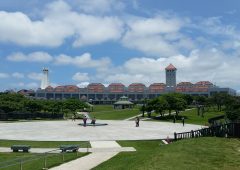2023.10.16
October 17th, Okinawa Soba Day
A bowl of soba is to Okinawa what a hamburger is to America. Here on the island you can see Okinawa soba signs everywhere. It has become entrenched in the Okinawan psyche. Those who are new to the island will inevitably be introduced to this dish. It is as much a part of the island’s culture as is Eisa or Awamori.
Since 1978, October 17th became known officially as “Okinawa Soba Day”. This was after the Japanese Fair Trade Commission announced that the noodles made within the prefecture can have its own special category; and “Okinawa Soba” it became! So why was the Fair Trade Commission even involved in what would seem to be a very trivial matter? After all, it was just a name. It turns out that mainland Japanese soba noodle is made up entirely different type of ingredient. Japanese soba noodles are made of buckwheat called “Sobako”. Okinawa soba noodles, on the other hand, is composed of flour, and thus the term “soba” could not be used to describe the Okinawan version. It was matter of technicality when it came to fair trade and commerce laws.
The noodles in Okinawa soba resembles udon noodles, while the soup taste like the soup found in ramen. The noodles differ slightly depending on the region. For example, in the Yaeyama Islands the noodles are circular, while elsewhere in Okinawa they are slightly flat. The noodles are served in a broth flavored with konbu seaweed, katsuobushi bonito flakes, pork, and chicken. Standard toppings are kamaboko fish cake, chopped welsh onion, and a thick slice of stewed pork belly or pork ribs. Pickled ginger is usually provided as garnish and a few drops of “Kore-gusu” (awamori spiced with hot peppers) gives it a nice zing.
Origins of Okinawa soba date back to the 1800’s, when a Chinese cook opened a restaurant named “Shina Soba” in Naha. As time passed, the dish became known as Okinawan soba which tasted more like ramen than the Japanese counterpart.
Following the reversion of Okinawa to mainland Japan, the organization governing fair trade claims stirred things up because according to their rules Okinawa soba could not be sold as soba because it was not made of buckwheat. Those involved in the claim noted that soba is defined to include at least 30% buckwheat. After lengthy negotiations, the Japanese government finally agreed to designate “Okinawa soba” as its own special name. Okinawa soba was finally officially endorsed and became a permanent fixture in Okinawan culture.
Today, there are more than 2,000 restaurants serving Okinawa soba and estimates are that 200,000 portions of soba are eaten each day. Almost all tourists to Okinawa try Okinawa soba. It’s one of most popular foods in Okinawa, and almost everyone who lives here has his or her favorite soba joint.
For this year’s Soba Day, 34 member shops belonging to the Okinawa Fresh Noodle Cooperative Association are organizing a special campaign which will lasts through February 29th, 2024. Anyone who orders soba from one of the thirty four participating restaurants will receive a stamp. If you collect all 34 stamps you will receive a certificate acknowledging you as an “Okinawa Soba Jyo-gu” , which means “Okinawa Soba Lover.” http://soba-okinawa.net/


 2024.07.12
2024.07.12 2024.07.07
2024.07.07 2024.07.02
2024.07.02 2024.06.21
2024.06.21 2024.06.11
2024.06.11 2024.06.08
2024.06.08 2024.06.03
2024.06.03 2024.05.30
2024.05.30 2024.05.25
2024.05.25






